Effect of Clay Brick Waste Powder on the Fresh and Hardened Properties of Self-Compacting Concrete: State-of-the-Art and Life Cycle Assessment
Abstract
1. Introduction
2. Characterization of CBWP
| Ref. | Year | Oxide, % | Fineness/Average Particle Size | ||||||||
|---|---|---|---|---|---|---|---|---|---|---|---|
| SiO2 | CaO | Al2O3 | Fe2O3 | MgO | SO3 | Alkalis (K2O + Na2O3) | L.O.I | WBCP | Cement | ||
| [49] | 2006 | 63.11 | 4.65 | 13.34 | 8.51 | 4.10 | 1.70 | 3.12 | 2.33 | 2005 cm2/g | 3030 cm2/g |
| [50] | 2010 | 41.61 | 14.34 | 14.76 | 11.47 | 6.04 | --- | --- | 2.33 | ≤45 µm | 3490 cm2/g |
| [51] | 2013 | 75.06 | 1.30 | 14.25 | 5.61 | 1.35 | 0.70 | 0.27 | 0.00 | --- | --- |
| [40] | 2013 | 53.78 | 12.88 | 16.61 | 6.22 | 2.20 | 0.65 | 3.00 | 3.13 | ≤80 µm | 4300 cm2/g |
| [41] | 2016 | 76.90 | 1.96 | 10.00 | 5.60 | 0.28 | 0.28 | 3.26 | 0.69 | ≤75 µm | --- |
| [52] | 2018 | 66.55 | 6.15 | 14.80 | 5.48 | 2.39 | --- | 2.13 | 1.48 | 3900, 4300 and 5200 cm2/g | 3850 cm2/g |
| [53] | 2019 | 56.86 | 7.88 | 15.53 | 7.63 | 2.95 | 0.55 | 3.85 | --- | 24.08 µm | 20.67 µm |
| [54] | 2020 | 58.41 | 15.81 | 9.72 | 5.47 | 2.13 | 0.27 | 1.87 | 3.45 | 4600 | 4640 |
| [55] | 2021 | 69.85 | 15.67 | 5.83 | 4.43 | 1.04 | 0.23 | 1.85 | 4.3 | 2.76 µm | 6.85 µm |
| [56] | 2021 | 62.80 | 1.70 | 10.40 | 16.30 | 2.20 | 0.60 | 2.70 | 0.50 | 24.80 µm | 11.14 µm |
3. Pozzolanic Activity of CBWP
4. Impact of CBWP on Properties of SCC
4.1. Workability
4.2. Hardened Properties
4.2.1. Compressive Strength
4.2.2. Splitting Tensile Strength
4.2.3. Flexural Strength
4.2.4. Water Absorption
4.2.5. Shrinkage
4.2.6. Sulfate Attack
4.2.7. Chloride Resistance
4.2.8. Carbonation Resistance
4.2.9. Microstructure
5. Discussion
6. Life Cycle Assessment (LCA)
- The final target is the production of 1 m3 of concrete (this includes extraction of raw materials, material production, preparation processes (e.g., grinding of the CBWP) and mixing of materials).
- As the CBWP could be collected from different places and the supply of the other raw materials varies, emissions from transportation were not considered in this research.
- A normalization approach was adapted in this research as not all the products developed the same compressive strength. The normalization was performed based on the impact per MPa of compressive strength of the concrete at 28 days and 360 days. Table 4 presents the results of compressive strength tests of the concrete as estimated from [51].
6.1. Acidification
6.2. Eutrophication
6.3. Global Warming Potential (GWP100a)
6.4. Ozone Layer Depletion
6.5. Depletion of Fossil Fuels (Energy Consumption)
7. Conclusions
- Brick waste consists mainly of aluminates and silicates, and the sum of the basic oxides is in accordance with the specifications of ASTM C618. Therefore, brick waste can be considered a pozzolanic material.
- Although very few studies have examined it, the proportion of the glass phase in the CBWP is relatively low, which explains the weak pozzolanic activity at early ages.
- CBWP can be used in proportions of 5 to 15% without significantly affecting the workability of SCC.
- Increased use of the superplasticizer improves the workability of CBWP-based SCC and reduces shear stresses. However, this is not recommended, as from an environmental point of view, increasing the superplasticizer could significantly increase the CO2 footprint along with the cost of SCC.
- Increased grinding reduces the sharp angles of the granules and makes them tend to be spherical, thus improving the workability.
- The upper limit for the use of brick waste is 10% to ensure that the mechanical performance (compressive, tensile and flexural strengths) is equivalent or slightly higher than that of SCC-free CBWP, and this effect appears at later ages (greater or equal to 90 days).
- The use of CBWP improved the durability properties (water absorption and shrinkage) of SCC at later ages, and it did not negatively affect the sulfate resistance. However, it causes an increase in the carbonation depth as a result of its pozzolanic activity.
- LCA was conducted to quantify the environmental impacts of different components of SCC. The results of the LCA indicated that cement has the largest impact among other ingredients of the SCC.
- Replacing the cement partially with CBWP resulted in a reduction in the environmental impacts of SCC.
- If the mechanical properties (compressive strength (MPa)) of SCC are taking into consideration in the calculation of the optimum CBWP content, the results indicated that replacing the cement with 37.5% CBWP provided the lowest environmental impacts per strength unit (MPa).
8. Future Works
- Critically reviewing the effect of using CBWP in SCC on non-destructive tests such as ultra-sonic pulse velocity test and rebound hammer test.
- Considering the post-use, transportation, and end of use of SCC in the calculations of LCA.
Author Contributions
Funding
Data Availability Statement
Acknowledgments
Conflicts of Interest
References
- Environment, U.N.; Scrivener, K.L.; John, V.M.; Gartner, E.M. Eco-efficient cements: Potential economically viable solutions for a low-CO2 cement-based materials industry. Cem. Concr. Res. 2018, 114, 2–26. [Google Scholar]
- Nasr, M.S.; Ali, I.M.; Hussein, A.M.; Shubbar, A.A.; Kareem, Q.T.; AbdulAmeer, A.T. Utilization of locally produced waste in the production of sustainable mortar. Case Stud. Constr. Mater. 2020, 13, e00464. [Google Scholar] [CrossRef]
- Habert, G.; Miller, S.A.; John, V.M.; Provis, J.L.; Favier, A.; Horvath, A.; Scrivener, K.L. Environmental impacts and decarbonization strategies in the cement and concrete industries. Nat. Rev. Earth Environ. 2020, 1, 559–573. [Google Scholar] [CrossRef]
- Tam, V.W.Y.; Soomro, M.; Evangelista, A.C.J. A review of recycled aggregate in concrete applications (2000–2017). Constr. Build. Mater. 2018, 172, 272–292. [Google Scholar] [CrossRef]
- Kisku, N.; Joshi, H.; Ansari, M.; Panda, S.K.; Nayak, S.; Dutta, S.C. A critical review and assessment for usage of recycled aggregate as sustainable construction material. Constr. Build. Mater. 2017, 131, 721–740. [Google Scholar] [CrossRef]
- Díaz, Y.C.; Berriel, S.S.; Heierli, U.; Favier, A.R.; Machado, I.R.S.; Scrivener, K.L.; Hernández, J.F.M.; Habert, G. Limestone calcined clay cement as a low-carbon solution to meet expanding cement demand in emerging economies. Dev. Eng. 2017, 2, 82–91. [Google Scholar] [CrossRef]
- Tayeh, B.A.; Hadzima-Nyarko, M.; Zeyad, A.M.; Al-Harazin, S.Z. Properties and durability of concrete with olive waste ash as a partial cement replacement. Adv. Concr. Constr. 2021, 11, 59–71. [Google Scholar]
- Letelier, V.; Henríquez-Jara, B.I.; Manosalva, M.; Parodi, C.; Ortega, J.M. Use of waste glass as a replacement for raw materials in mortars with a lower environmental impact. Energies 2019, 12, 1974. [Google Scholar] [CrossRef]
- Adesina, A. Recent advances in the concrete industry to reduce its carbon dioxide emissions. Environ. Chall. 2020, 1, 100004. [Google Scholar] [CrossRef]
- Shubbar, A.A.F.; Jafer, H.M.; Dulaimi, A.F.D.; Atherton, W.; Al-Rifaie, A. The Development of a Low Carbon Cementitious Material Produced from Cement, Ground Granulated Blast Furnace Slag and High Calcium Fly Ash. Int. J. Civ. Environ. Struct. Constr. Archit. Eng. 2017, 11, 905–908. [Google Scholar]
- Nasr, M.S.; Hasan, Z.A.; Abed, M.K.; Dhahir, M.K.; Najim, W.N.; Shubbar, A.A.; Dhahir, H.Z. Utilization of High Volume Fraction of Binary Combinations of Supplementary Cementitious Materials in the Production of Reactive Powder Concrete. Period. Polytech. Civ. Eng. 2021, 65, 335–343. [Google Scholar] [CrossRef]
- Atef, M.; Bassioni, G.; Azab, N.; Abdellatif, M.H. Assessment of cement replacement with fine recycled rubber particles in sustainable cementitious composites. J. Mech. Behav. Mater. 2021, 30, 59–65. [Google Scholar] [CrossRef]
- Hamad, M.A.; Nasr, M.; Shubbar, A.; Al-Khafaji, Z.; Al Masoodi, Z.; Al-Hashimi, O.; Kot, P.; Alkhaddar, R.; Hashim, K. Production of Ultra-High-Performance Concrete with Low Energy Consumption and Carbon Footprint Using Supplementary Cementitious Materials Instead of Silica Fume: A Review. Energies 2021, 14, 8291. [Google Scholar] [CrossRef]
- Hawileh, R.A.; Abdalla, J.A.; Fardmanesh, F.; Shahsana, P.; Khalili, A. Performance of reinforced concrete beams cast with different percentages of GGBS replacement to cement. Arch. Civ. Mech. Eng. 2017, 17, 511–519. [Google Scholar] [CrossRef]
- Tayeh, B.A.; Hasaniyah, M.W.; Zeyad, A.M.; Awad, M.M.; Alaskar, A.; Mohamed, A.M.; Alyousef, R. Durability and mechanical properties of seashell partially-replaced cement. J. Build. Eng. 2020, 101328. [Google Scholar] [CrossRef]
- Aziz, M.A.; Zubair, M.; Saleem, M.; Alharthi, Y.M.; Ashraf, N.; Alotaibi, K.S.; Aga, O.; Al Eid, A.A.A. Mechanical, non-destructive, and thermal characterization of biochar-based mortar composite. Biomass Convers. Biorefinery 2023, 1–14. [Google Scholar] [CrossRef]
- Sakir, S.; Raman, S.N.; Kaish, A.B.M.A. Utilization of By-Products and Wastes as Supplementary Cementitious Materials in Structural Mortar for Sustainable Construction. Sustainability 2020, 12, 3888. [Google Scholar] [CrossRef]
- Kubba, H.Z.; Nasr, M.S.; Al-Abdaly, N.M.; Dhahir, M.K.; Najim, W.N. Influence of Incinerated and Non-Incinerated waste paper on Properties of Cement Mortar. IOP Conf. Ser. Mater. Sci. Eng. 2020, 671, 012113. [Google Scholar] [CrossRef]
- Adesina, A.; Awoyera, P. Overview of trends in the application of waste materials in self-compacting concrete production. SN Appl. Sci. 2019, 1, 962. [Google Scholar] [CrossRef]
- Bektas, F.; Turanli, L.; Wang, K.; Ceylan, H. Comparative performance of ground clay brick in mitigation of alkali–silica reaction. J. Mater. Civ. Eng. 2007, 19, 1070–1078. [Google Scholar] [CrossRef]
- Zheng, L.; Ge, Z.; Yao, Z.Y.; Sun, R.J.; Dong, J.G. The properties of concrete with recycled clay-brick-powder. Appl. Mech. Mater. 2011, 99, 826–831. [Google Scholar] [CrossRef]
- Zhao, Y.; Gao, J.; Xu, Z.; Li, S.; Luo, X.; Chen, G. Long-term hydration and microstructure evolution of blended cement containing ground granulated blast furnace slag and waste clay brick. Cem. Concr. Compos. 2021, 118, 103982. [Google Scholar] [CrossRef]
- Schackow, A.; Stringari, D.; Senff, L.; Correia, S.L.; Segadães, A.M. Influence of fired clay brick waste additions on the durability of mortars. Cem. Concr. Compos. 2015, 62, 82–89. [Google Scholar] [CrossRef]
- Li, H.; Dong, L.; Jiang, Z.; Yang, X.; Yang, Z. Study on utilization of red brick waste powder in the production of cement-based red decorative plaster for walls. J. Clean. Prod. 2016, 133, 1017–1026. [Google Scholar] [CrossRef]
- Al-Hadithi, A.I.; Hilal, N.N. The possibility of enhancing some properties of self-compacting concrete by adding waste plastic fibers. J. Build. Eng. 2016, 8, 20–28. [Google Scholar] [CrossRef]
- Shi, C.; Wu, Z.; Lv, K.; Wu, L. A review on mixture design methods for self-compacting concrete. Constr. Build. Mater. J. 2015, 84, 387–398. [Google Scholar] [CrossRef]
- Zhang, H.; Yuan, H.; Ge, Z.; Wu, J.; Fang, C.; Schlangen, E.; Šavija, B. Fresh and hardened properties of self-compacting concrete containing recycled fine clay brick aggregates. Mater. Struct. 2021, 54, 159. [Google Scholar] [CrossRef]
- Sun, C.; Chen, Q.; Xiao, J.; Liu, W. Utilization of waste concrete recycling materials in self-compacting concrete. Resour. Conserv. Recycl. 2020, 161, 104930. [Google Scholar] [CrossRef]
- Gupta, N.; Siddique, R.; Belarbi, R. Sustainable and greener self-compacting concrete incorporating industrial by-products: A review. J. Clean. Prod. 2021, 284, 124803. [Google Scholar] [CrossRef]
- Kumar, K.R.; Shyamala, G.; Awoyera, P.O.; Vedhasakthi, K.; Olalusi, O.B. Cleaner production of self-compacting concrete with selected industrial rejects-an overview. Silicon 2021, 13, 2809–2820. [Google Scholar] [CrossRef]
- Duan, Z.; Singh, A.; Xiao, J.; Hou, S. Combined use of recycled powder and recycled coarse aggregate derived from construction and demolition waste in self-compacting concrete. Constr. Build. Mater. 2020, 254, 119323. [Google Scholar] [CrossRef]
- Gautam, L.; Jain, J.K.; Jain, A.; Kalla, P. Valorization of bone-china ceramic powder waste along with granite waste in self-compacting concrete. Constr. Build. Mater. 2022, 315, 125730. [Google Scholar] [CrossRef]
- Li, L.G.; Lin, Z.H.; Chen, G.M.; Kwan, A.K.H. Reutilizing clay brick dust as paste substitution to produce environment-friendly durable mortar. J. Clean. Prod. 2020, 274, 122787. [Google Scholar] [CrossRef]
- Huarachi, D.A.R.; Goncalves, G.; de Francisco, A.C.; Canteri, M.H.G.; Piekarski, C.M. Life cycle assessment of traditional and alternative bricks: A review. Environ. Impact Assess. Rev. 2020, 80, 106335. [Google Scholar] [CrossRef]
- Standardization, I.O. Environmental Management: Life Cycle Assessment; Requirements and Guidelines; ISO: Geneva, Switzerland, 2006; Volume 14044. [Google Scholar]
- Seco, A.; Omer, J.; Marcelino, S.; Espuelas, S.; Prieto, E. Sustainable unfired bricks manufacturing from construction and demolition wastes. Constr. Build. Mater. 2018, 167, 154–165. [Google Scholar] [CrossRef]
- De Miranda Santos, S.D.F.O.; Piekarski, C.M.; Ugaya, C.M.L.; Donato, D.B.; Braghini Júnior, A.; De Francisco, A.C.; Carvalho, A.M.M.L. Life cycle analysis of charcoal production in masonry kilns with and without carbonization process generated gas combustion. Sustainability 2017, 9, 1558. [Google Scholar] [CrossRef]
- Buyle, M.; Braet, J.; Audenaert, A. Life cycle assessment in the construction sector: A review. Renew. Sustain. Energy Rev. 2013, 26, 379–388. [Google Scholar] [CrossRef]
- Boucherit, D.; Debiebt, F.; Kenai, S.; Khalfaoui, M.A.; Chellali, S. Experimental Study on Marble and Brick Powders as Partial Replacement of Cement in Self-compacting Mortar. Curr. Mater. Sci. Former. Recent Pat. Mater. Sci. 2020, 13, 45–57. [Google Scholar] [CrossRef]
- Abib, Z.E.; Gaher-Abib, H.; Kharchi, F. Effect of clay fines on the behavior of self-compacting concrete. Engineering 2013, 5, 213–218. [Google Scholar] [CrossRef]
- Mansor, A.M.; Hamed, A.M.M.; Borg, R.P. Effect of fine clay brick waste on the properties of self compacting concrete. Alex. Eng. J. 2016, 1–7. [Google Scholar]
- Aliabdo, A.A.; Abd-Elmoaty, A.-E.M.; Hassan, H.H. Utilization of crushed clay brick in concrete industry. Alex. Eng. J. 2014, 53, 151–168. [Google Scholar] [CrossRef]
- He, Z.; Shen, A.; Wu, H.; Wang, W.; Wang, L.; Yao, C.; Wu, J. Research progress on recycled clay brick waste as an alternative to cement for sustainable construction materials. Constr. Build. Mater. 2021, 274, 122113. [Google Scholar] [CrossRef]
- Lam, M.N.-T.; Nguyen, D.-T.; Nguyen, D.-L. Potential use of clay brick waste powder and ceramic waste aggregate in mortar. Constr. Build. Mater. 2021, 313, 125516. [Google Scholar] [CrossRef]
- Kolawole, J.T.; Olusola, K.O.; Babafemi, A.J.; Olalusi, O.B.; Fanijo, E. Blended cement binders containing bamboo leaf ash and ground clay brick waste for sustainable concrete. Materialia 2021, 15, 101045. [Google Scholar] [CrossRef]
- Shao, J.; Gao, J.; Zhao, Y.; Chen, X. Study on the pozzolanic reaction of clay brick powder in blended cement pastes. Constr. Build. Mater. 2019, 213, 209–215. [Google Scholar] [CrossRef]
- Ouyang, X.; Wang, L.; Fu, J.; Xu, S.; Ma, Y. Surface properties of clay brick powder and its influence on hydration and strength development of cement paste. Constr. Build. Mater. 2021, 300, 123958. [Google Scholar] [CrossRef]
- Zhao, Y.; Gao, J.; Liu, C.; Chen, X.; Xu, Z. The particle-size effect of waste clay brick powder on its pozzolanic activity and properties of blended cement. J. Clean. Prod. 2020, 242, 118521. [Google Scholar] [CrossRef]
- Şahmaran, M.; Christianto, H.A.; Yaman, İ.Ö. The effect of chemical admixtures and mineral additives on the properties of self-compacting mortars. Cem. Concr. Compos. 2006, 28, 432–440. [Google Scholar] [CrossRef]
- Karatas, M.; Turk, K.; Acikgenc, M.; Ulucan, Z.C. Effect of elazig region waste brick powder on strength and viscosity properties of self compacting mortar. In Proceedings of the 9th International Congress on Advances in Civil Engineering, Trabzon, Turkey, 27–30 September 2010. [Google Scholar]
- Heikal, M.; Zohdy, K.M.; Abdelkreem, M. Mechanical, microstructure and rheological characteristics of high performance self-compacting cement pastes and concrete containing ground clay bricks. Constr. Build. Mater. 2013, 38, 101–109. [Google Scholar] [CrossRef]
- Irki, I.; Debieb, F.; Ouzadid, S.; Dilmi, H.L.; Settari, C.; Boukhelkhel, D. Effect of Blaine fineness of recycling brick powder replacing cementitious materials in self compacting mortar. J. Adhes. Sci. Technol. 2018, 32, 963–975. [Google Scholar] [CrossRef]
- Silva, Y.F.; Lange, D.A.; Delvasto, S. Effect of incorporation of masonry residue on the properties of self-compacting concretes. Constr. Build. Mater. 2019, 196, 277–283. [Google Scholar] [CrossRef]
- Si-Ahmed, M.; Kenai, S. Behavior of self-compacting mortars based on waste brick powder. Curr. Mater. Sci. Former. Recent Pat. Mater. Sci. 2020, 13, 39–44. [Google Scholar] [CrossRef]
- Shah, M.U.; Usman, M.; Hanif, M.U.; Naseem, I.; Farooq, S. Utilization of Solid Waste from Brick Industry and Hydrated Lime in Self-Compacting Cement Pastes. Materials 2021, 14, 1109. [Google Scholar] [CrossRef]
- Zhao, Z.; Grellier, A.; Bouarroudj, M.E.K.; Michel, F.; Bulteel, D.; Courard, L. Substitution of limestone filler by waste brick powder in self-compacting mortars: Properties and durability. J. Build. Eng. 2021, 43, 102898. [Google Scholar] [CrossRef]
- Sun, R.; Huang, D.; Ge, Z.; Hu, Y.; Guan, Y. Properties of self-consolidating concrete with recycled clay-brick-powder replacing cementitious material. J. Sustain. Cem. Mater. 2014, 3, 211–219. [Google Scholar] [CrossRef]
- Amjadi, R.; Monazami, M.; Mohseni, E.; Azar Balgouri, H.; Ranjbar, M.M. Effectiveness of different recycled materials in self-compacting mortar. Eur. J. Environ. Civ. Eng. 2017, 21, 1485–1501. [Google Scholar] [CrossRef]
- Abdulrazzaq, O.A. Effect of Clay Bricks Powder on the Fresh and Hardened Properties of Self-Compacting Concrete. Iraqi J. Civ. Eng. 2018, 12, 78–89. [Google Scholar]
- Silva, Y.F.; Delvasto, S. Sulfate attack resistance of self-compacting concrete with residue of masonry. Constr. Build. Mater. 2021, 268, 121095. [Google Scholar] [CrossRef]
- Silva, Y.F.; Delvasto, S. Durability of self-compacting concrete with addition of residue of masonry when exposed to carbonation and chlorides mediums. Constr. Build. Mater. 2021, 297, 123817. [Google Scholar] [CrossRef]
- Dehestani, M.; Nikbin, I.M.; Asadollahi, S. Effects of specimen shape and size on the compressive strength of self-consolidating concrete (SCC). Constr. Build. Mater. 2014, 66, 685–691. [Google Scholar] [CrossRef]
- Silva, Y.F.; Delvasto, S.; Izquierdo, S.; Araya-Letelier, G. Short and long-term physical and mechanical characterization of self-compacting concrete made with masonry and concrete residue. Constr. Build. Mater. 2021, 312, 125382. [Google Scholar] [CrossRef]
- Zain, M.F.M.; Mahmud, H.B.; Ilham, A.; Faizal, M. Prediction of splitting tensile strength of high-performance concrete. Cem. Concr. Res. 2002, 32, 1251–1258. [Google Scholar] [CrossRef]
- Meisuh, B.K.; Kankam, C.K.; Buabin, T.K. Effect of quarry rock dust on the flexural strength of concrete. Case Stud. Constr. Mater. 2018, 8, 16–22. [Google Scholar] [CrossRef]
- Nasr, M.S.; Hussain, T.H.; Kubba, H.Z.; Shubbar, A.A. Influence of using high volume fraction of silica fume on mechanical and durability properties of cement mortar. J. Eng. Sci. Technol. 2020, 15, 2492–2506. [Google Scholar]
- Robayo-Salazar, R.A.; Mejía-Arcila, J.M.; de Gutiérrez, R.M. Eco-efficient alkali-activated cement based on red clay brick wastes suitable for the manufacturing of building materials. J. Clean. Prod. 2017, 166, 242–252. [Google Scholar] [CrossRef]
- Marcelino-Sadaba, S.; Kinuthia, J.; Oti, J.; Meneses, A.S. Challenges in Life Cycle Assessment (LCA) of stabilised clay-based construction materials. Appl. Clay Sci. 2017, 144, 121–130. [Google Scholar] [CrossRef]
- Cape, J.N.; Fowler, D.; Davison, A. Ecological effects of sulfur dioxide, fluorides, and minor air pollutants: Recent trends and research needs. Environ. Int. 2003, 29, 201–211. [Google Scholar] [CrossRef]
- Freitas, F.F.; Furtado, A.C.; Piñas, J.A.V.; Venturini, O.J.; Barros, R.M.; Lora, E.E.S. Holistic Life Cycle Assessment of a biogas-based electricity generation plant in a pig farm considering co-digestion and an additive. Energy 2022, 261, 125340. [Google Scholar] [CrossRef]
- Movilla-Quesada, D.; Lagos-Varas, M.; Raposeiras, A.C.; Muñoz-Cáceres, O.; Andrés-Valeri, V.C.; Aguilar-Vidal, C. Analysis of greenhouse gas emissions and the environmental impact of the production of asphalt mixes modified with recycled materials. Sustainability 2021, 13, 8081. [Google Scholar] [CrossRef]
- Di Filippo, R.; Bursi, O.S.; Di Maggio, R. Global warming and ozone depletion potentials caused by emissions from HFC and CFC banks due to structural damage. Energy Build. 2022, 273, 112385. [Google Scholar] [CrossRef]
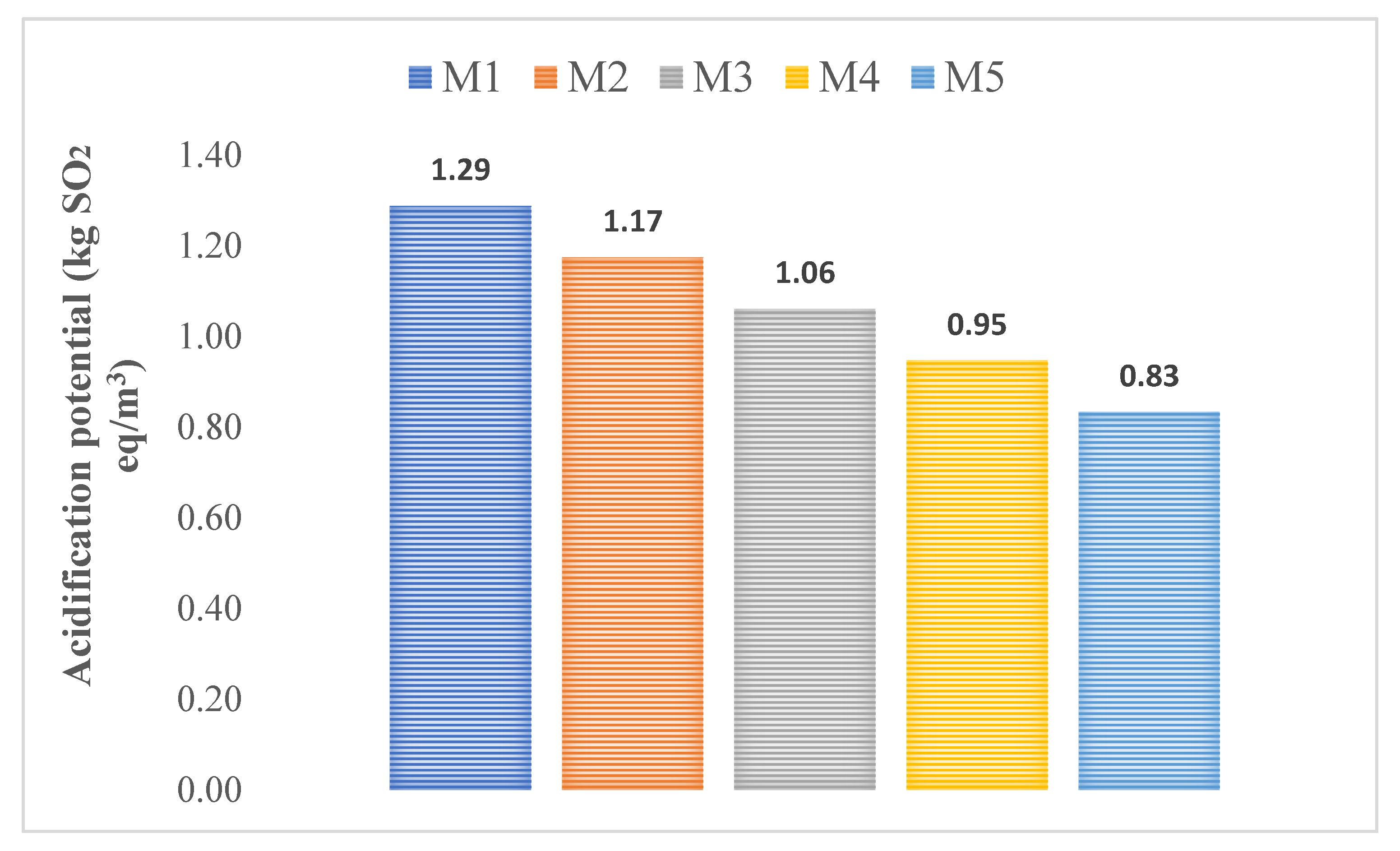


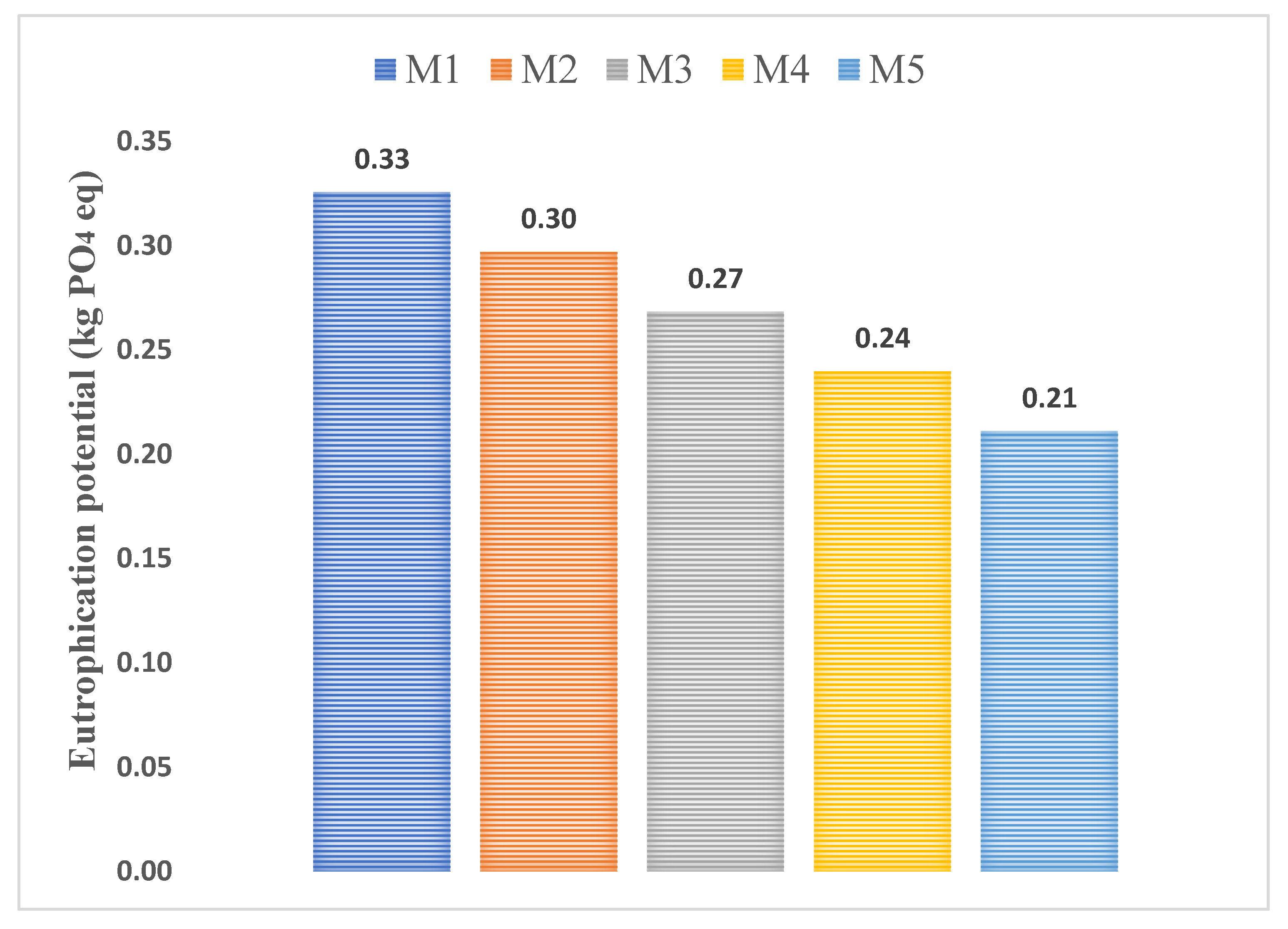
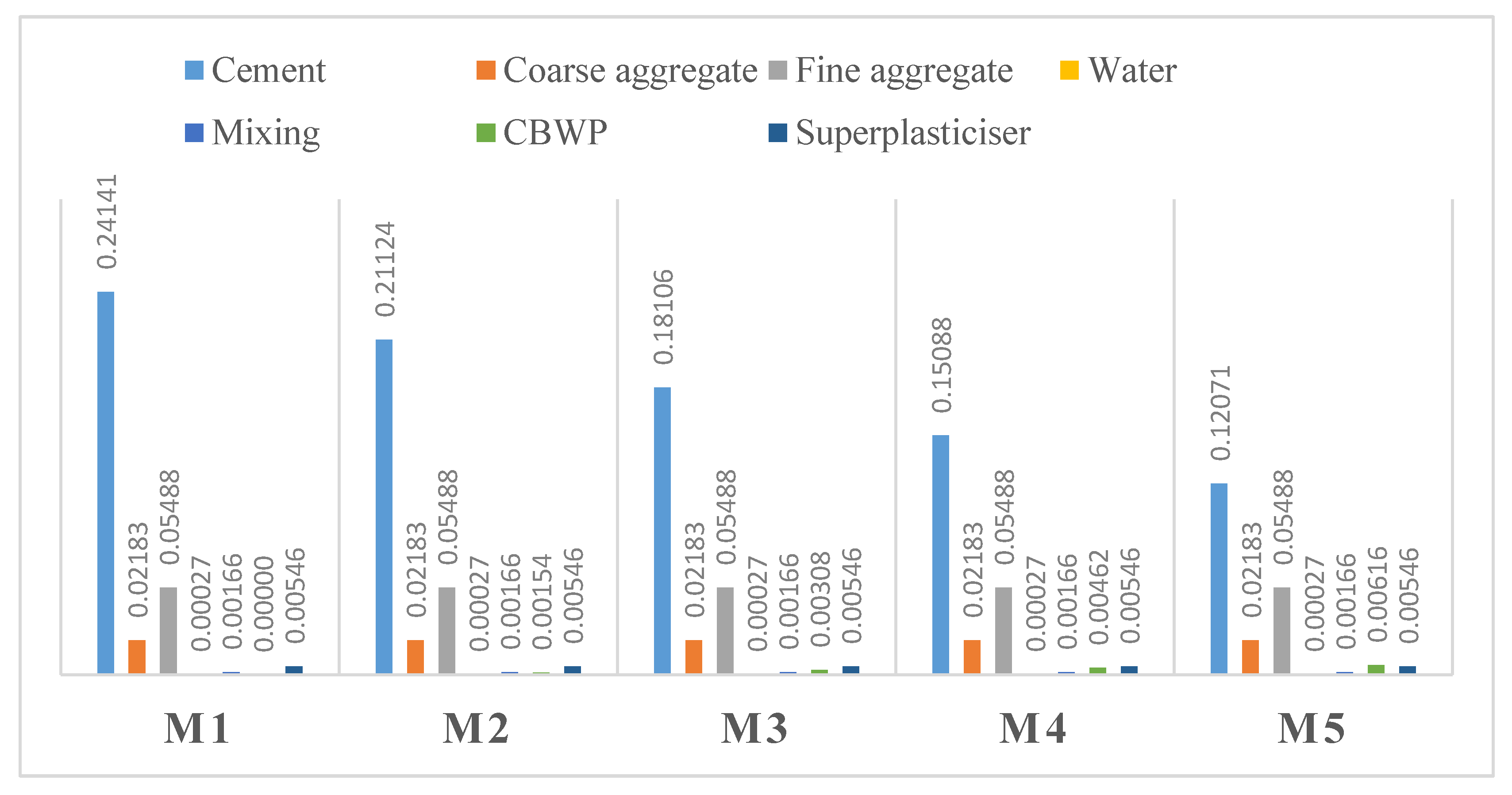
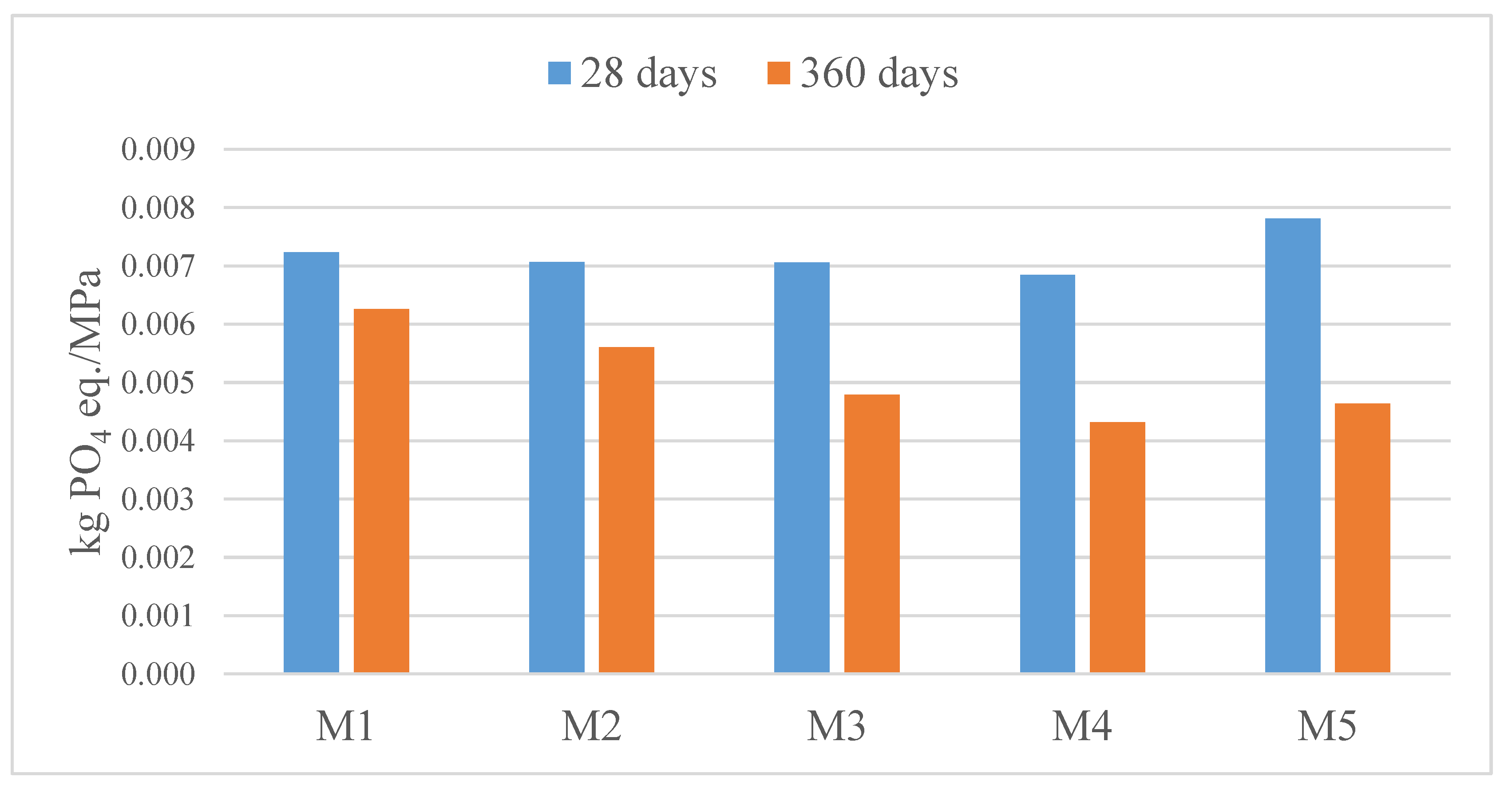
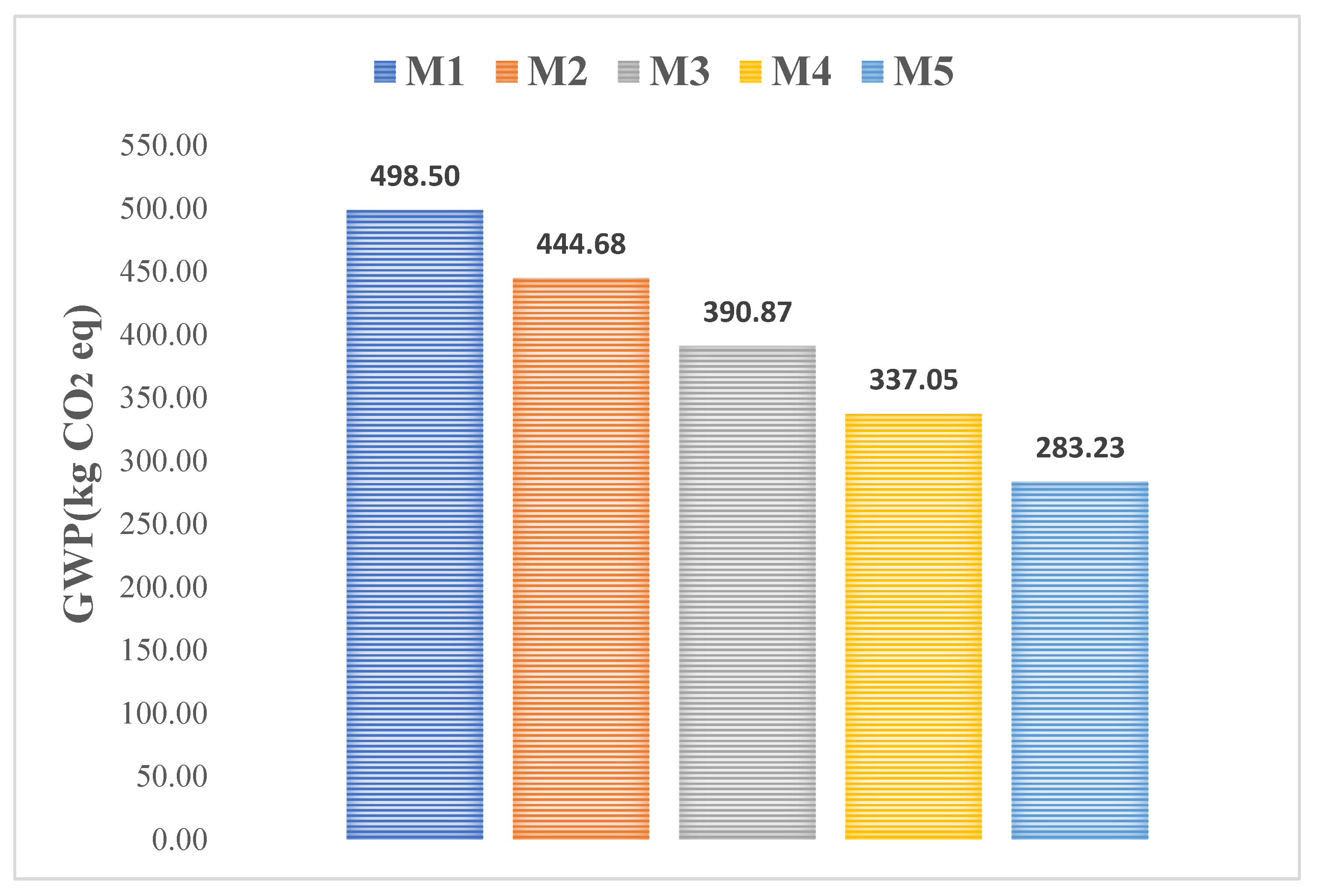
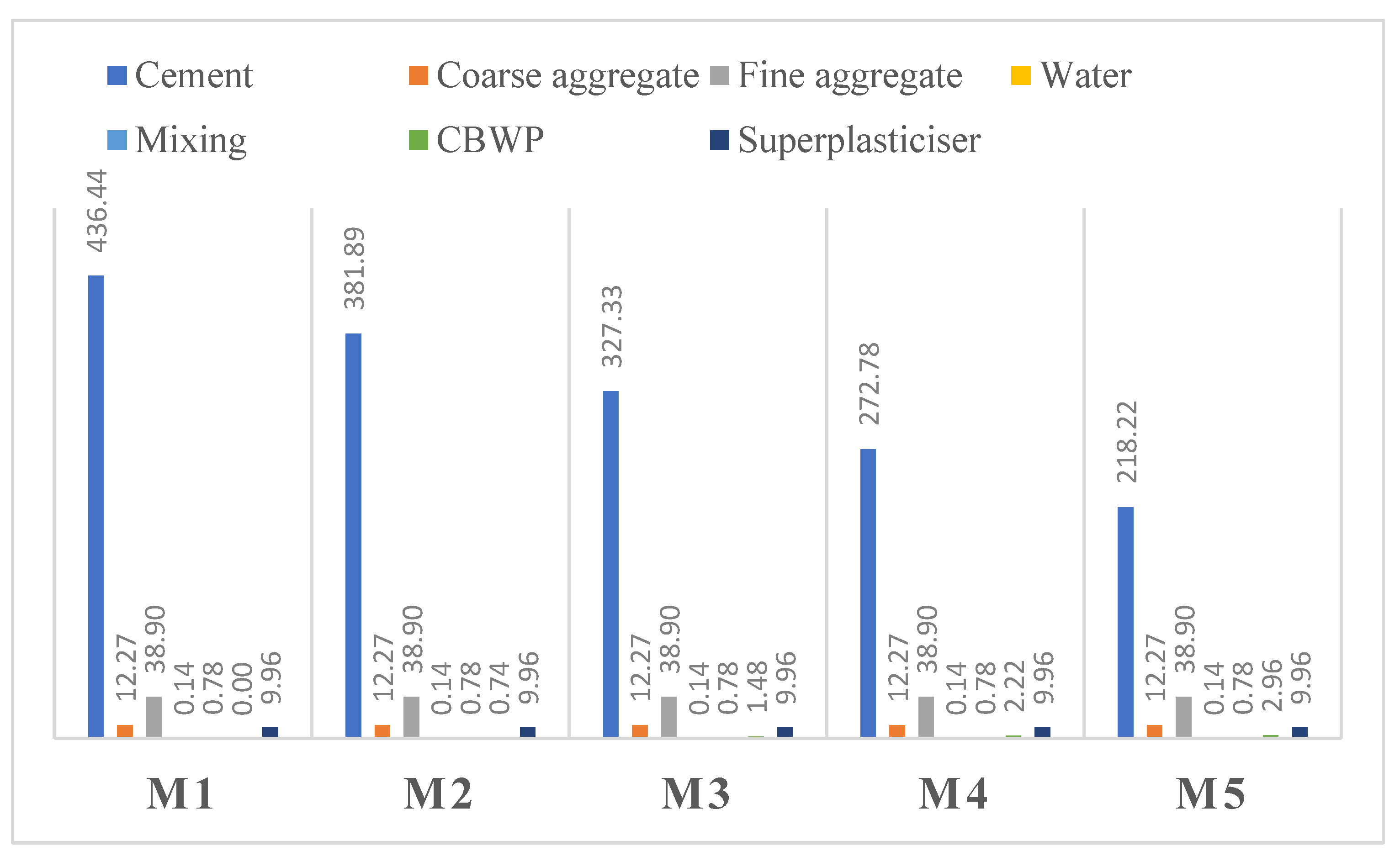
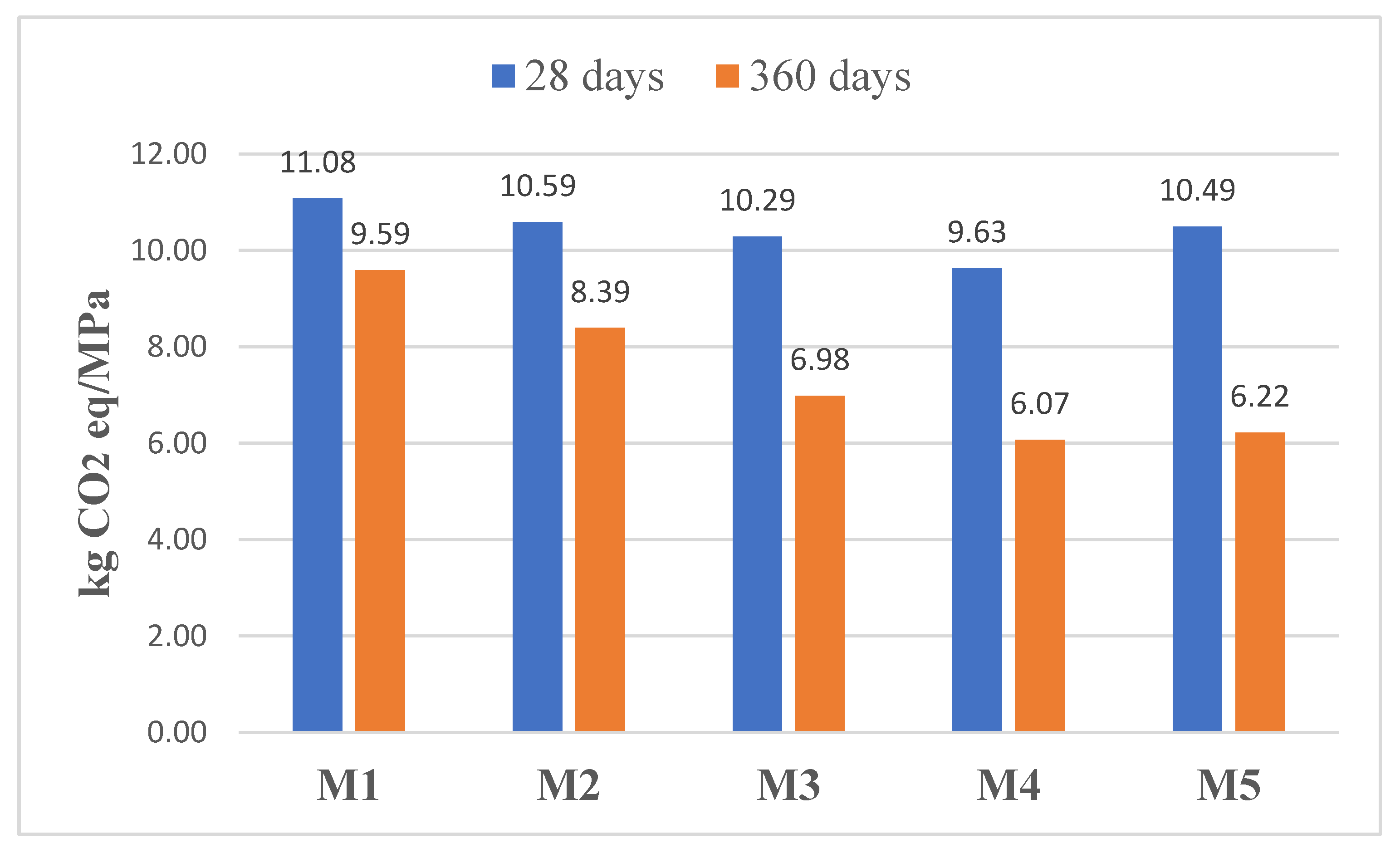
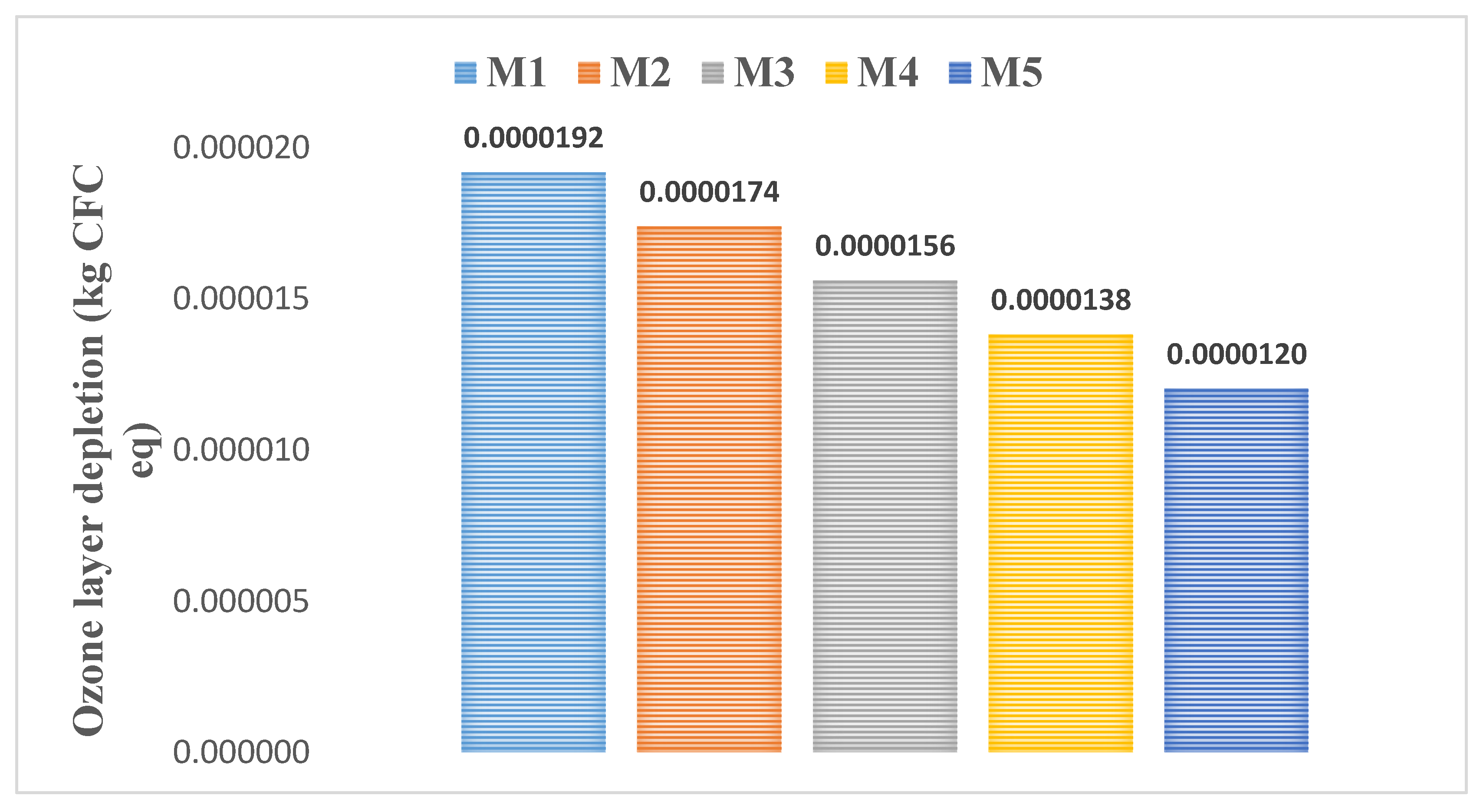
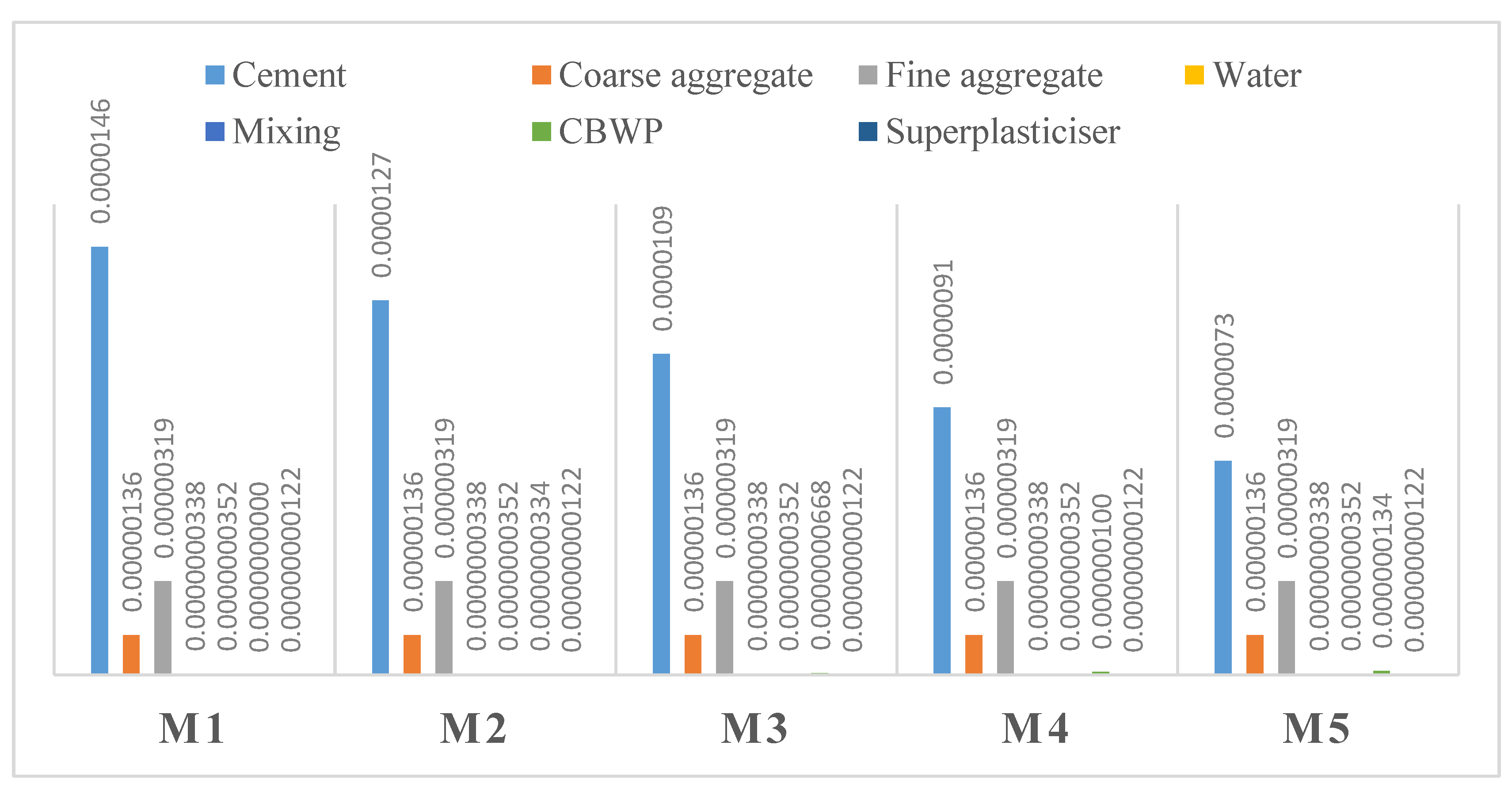

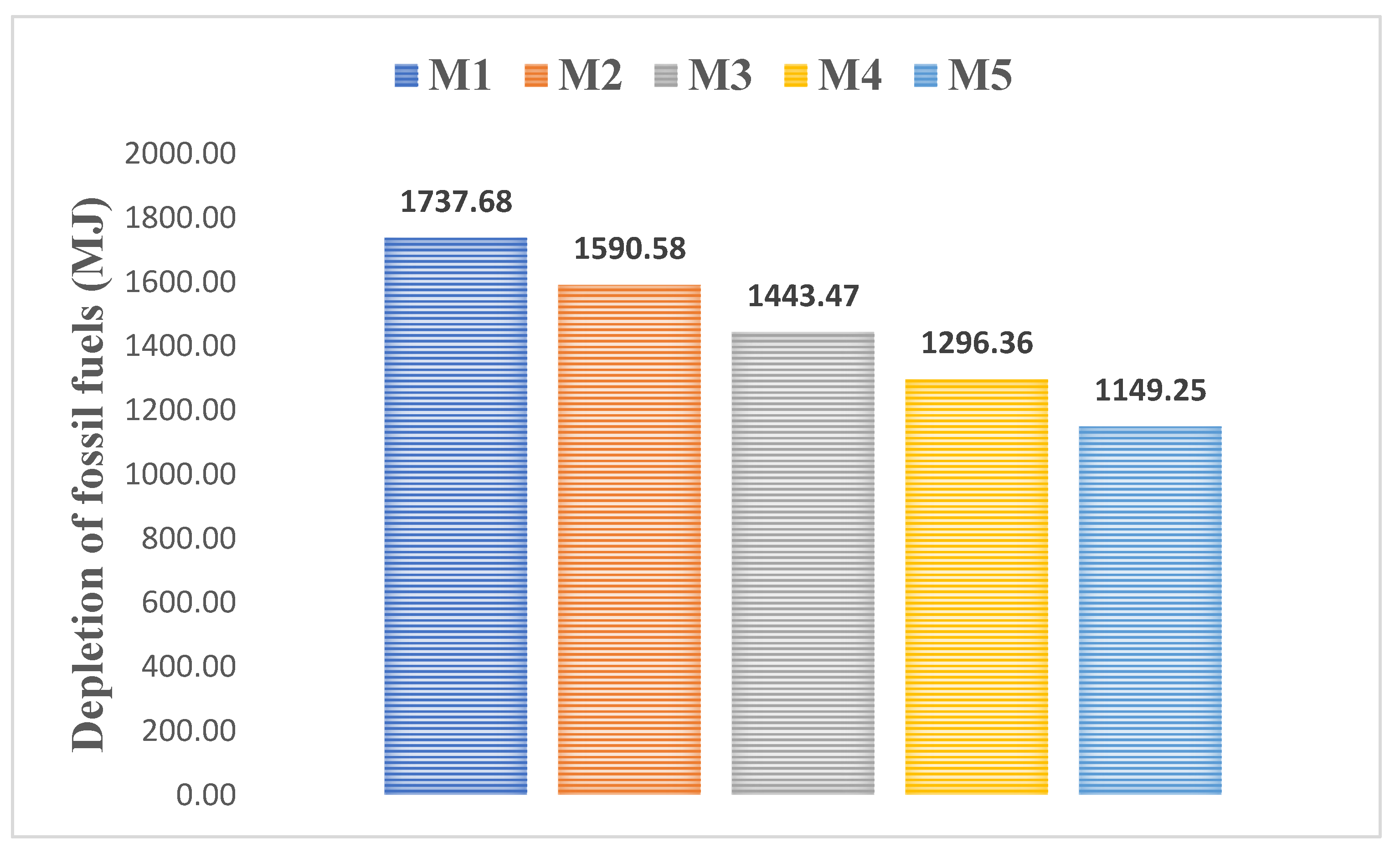
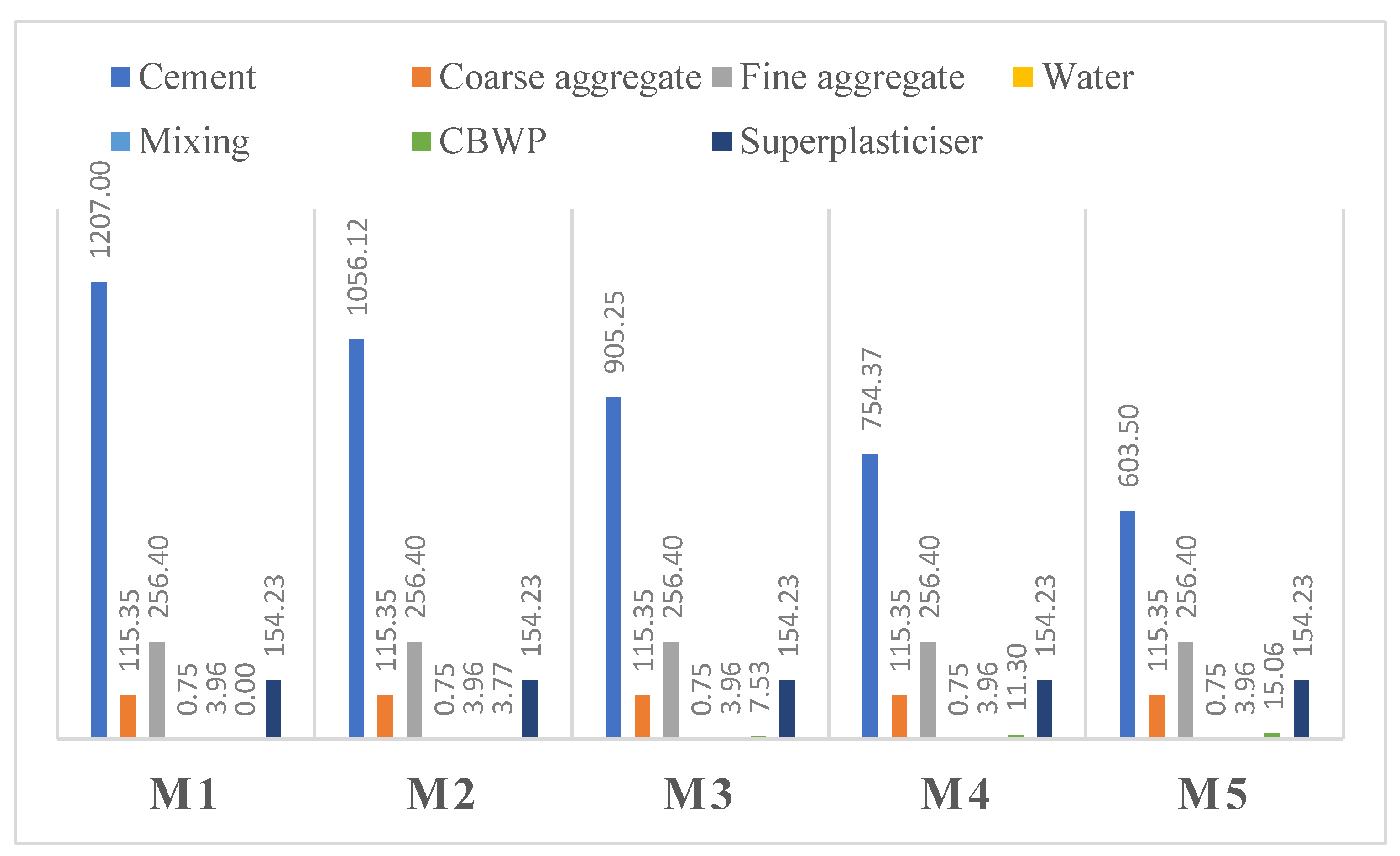
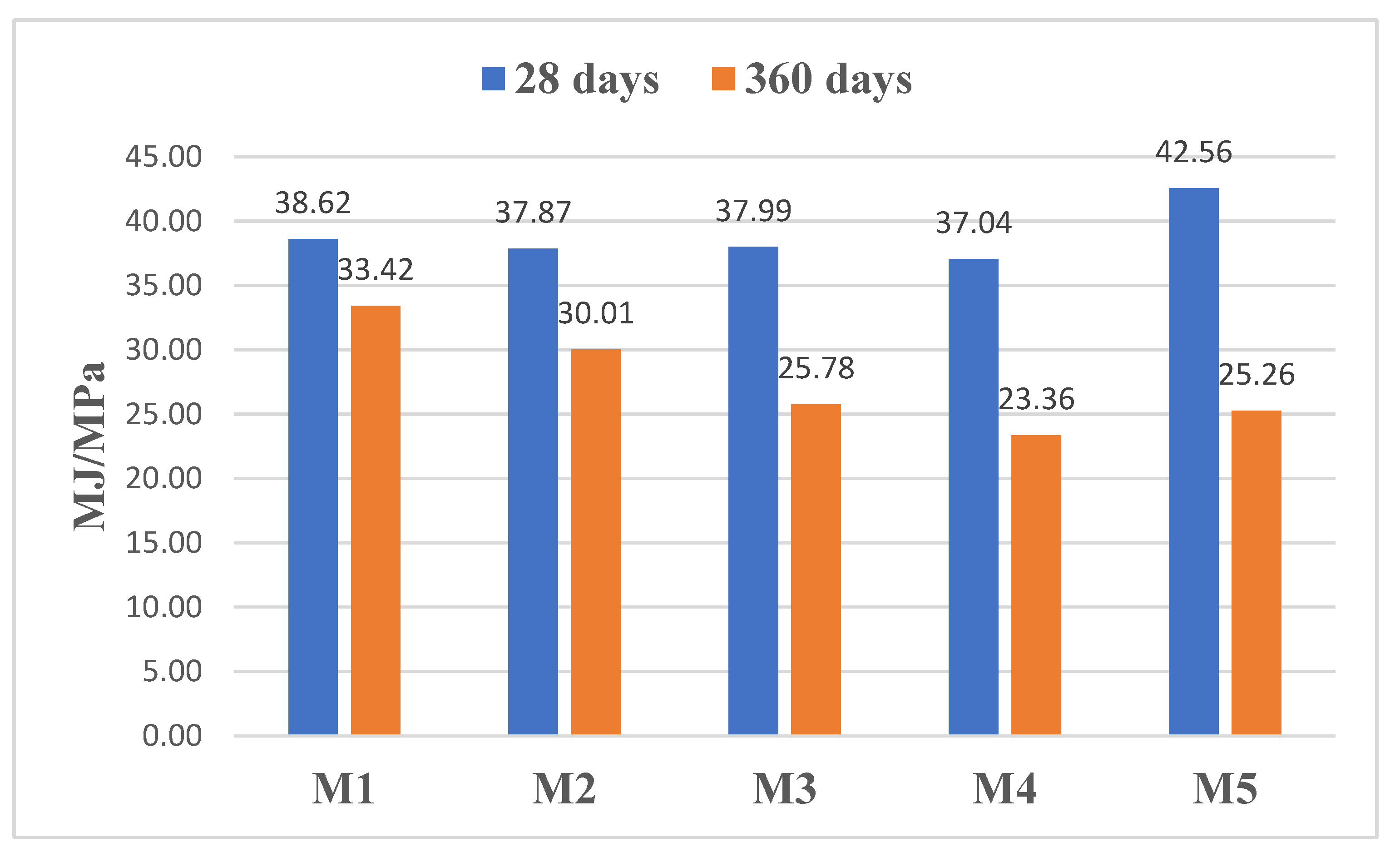
| Ref. | Year | Replacement, % | Tests | Testing Age (Days) | Main Findings |
|---|---|---|---|---|---|
| [49] | 2006 | 0, 15 and 30% | Workability, setting time, density, ultrasonic pulse velocity (UPV) and compressive strength | 28 and 56 |
|
| [50] | 2010 | 0, 5, 10, 15, 20, 25 and 30% | Workability, compressive strength and bending tensile strength | 3, 7, 28 and 91 |
|
| [51] | 2013 | 0, 12.5, 25, and 37.5% | Rheological properties, compressive strength and microstructure | 7, 28, 366 and 1095 |
|
| [57] | 2014 | 0, 1, 2.5 and 5% | Workability, compressive strength, autogenous shrinkage and microstructure | 7, 28 and 56 |
|
| [41] | 2016 | 0, 5, 10, 15, 20, 25, 30, 35, 40, 45 and 50% | Workability, compressive strength and splitting tensile strength | 28 |
|
| [58] | 2016 | 0, 5, 10, and 15% | Workability, compressive strength, water absorption and microstructure | 7, 14, 28 and 90 |
|
| [59] | 2018 | 0, 5, 10, and 15% | Workability, splitting tensile strength, compressive strength and modulus of elasticity | 7 and 28 |
|
| [52] | 2018 | 0, 5, 10, 15 and 20% | Workability, compressive strength and splitting tensile strength | 7, 28 and 90 |
|
| [54] | 2020 | 0, 5, 10, 15 20 and 25% | Workability, compressive strength and capillary water absorption | 7 and 28 |
|
| [60] | 2021 | 0, 25 and 50% by volume | Workability and sulfate resistance | 28, 90, 180 and 360 days |
|
| [55] | 2021 | 0, 5, 10, and 20% | Water and SP demands, setting time, mechanical strength and early age shrinkage | 3, 7, 28, 60, and 90 |
|
| [61] | 2021 | 0, 25 and 50% by volume | Workability, compressive strength, permeability, carbonation depth, chloride penetration and microstructure | 7, 28, 90, 180, 360 and 720 |
|
| [56] | 2021 | 0, 50 and 100% of limestone filler | Compressive and flexural strengths, water absorption, drying shrinkage, carbonation, chloride ion diffusion and sulfate resistance | 7, 14, 28 and 90 |
|
| Mix Id | Cement | CBWP | Fine Aggregate | Coarse Aggregate | Water | Superplasticizer |
|---|---|---|---|---|---|---|
| M1 | 500 | 0 | 895.1 | 686.2 | 202.5 | 5.3 |
| M2 | 437.5 | 53.2 | 895.1 | 686.2 | 202.5 | 5.3 |
| M3 | 375 | 106.4 | 895.1 | 686.2 | 202.5 | 5.3 |
| M4 | 312.5 | 159.6 | 895.1 | 686.2 | 202.5 | 5.3 |
| M5 | 250 | 212.8 | 895.1 | 686.2 | 202.5 | 5.3 |
| 28 Days | 360 Days | |
|---|---|---|
| M1 | 45 | 52 |
| M2 | 42 | 53 |
| M3 | 38 | 56 |
| M4 | 35 | 55.5 |
| M5 | 27 | 45.5 |
Disclaimer/Publisher’s Note: The statements, opinions and data contained in all publications are solely those of the individual author(s) and contributor(s) and not of MDPI and/or the editor(s). MDPI and/or the editor(s) disclaim responsibility for any injury to people or property resulting from any ideas, methods, instructions or products referred to in the content. |
© 2023 by the authors. Licensee MDPI, Basel, Switzerland. This article is an open access article distributed under the terms and conditions of the Creative Commons Attribution (CC BY) license (https://creativecommons.org/licenses/by/4.0/).
Share and Cite
Nasr, M.S.; Salman, A.J.; Ghayyib, R.J.; Shubbar, A.; Al-Mamoori, S.; Al-khafaji, Z.; Hashim, T.M.; Hasan, Z.A.; Sadique, M. Effect of Clay Brick Waste Powder on the Fresh and Hardened Properties of Self-Compacting Concrete: State-of-the-Art and Life Cycle Assessment. Energies 2023, 16, 4587. https://doi.org/10.3390/en16124587
Nasr MS, Salman AJ, Ghayyib RJ, Shubbar A, Al-Mamoori S, Al-khafaji Z, Hashim TM, Hasan ZA, Sadique M. Effect of Clay Brick Waste Powder on the Fresh and Hardened Properties of Self-Compacting Concrete: State-of-the-Art and Life Cycle Assessment. Energies. 2023; 16(12):4587. https://doi.org/10.3390/en16124587
Chicago/Turabian StyleNasr, Mohammed Salah, Awham Jumah Salman, Rusul Jaber Ghayyib, Ali Shubbar, Shahad Al-Mamoori, Zainab Al-khafaji, Tameem Mohammed Hashim, Zaid Ali Hasan, and Monower Sadique. 2023. "Effect of Clay Brick Waste Powder on the Fresh and Hardened Properties of Self-Compacting Concrete: State-of-the-Art and Life Cycle Assessment" Energies 16, no. 12: 4587. https://doi.org/10.3390/en16124587
APA StyleNasr, M. S., Salman, A. J., Ghayyib, R. J., Shubbar, A., Al-Mamoori, S., Al-khafaji, Z., Hashim, T. M., Hasan, Z. A., & Sadique, M. (2023). Effect of Clay Brick Waste Powder on the Fresh and Hardened Properties of Self-Compacting Concrete: State-of-the-Art and Life Cycle Assessment. Energies, 16(12), 4587. https://doi.org/10.3390/en16124587








